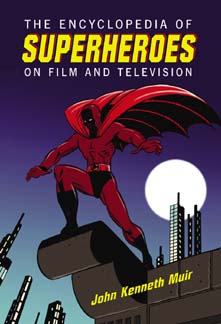|
July 2006
Superman Returns…but From Where?<
Media Commentary by John Kenneth Muir
 This July—the very month of our country’s independence—our nation celebrates in theaters (and toy stores…) the premiere of Bryan Singer’s epic cinematic event, Superman Returns. The film is appropriately titled since it heralds the encore appearance of one of America’s most durable mythological heroes; our very own Hercules, Theseus or Robin Hood. This July—the very month of our country’s independence—our nation celebrates in theaters (and toy stores…) the premiere of Bryan Singer’s epic cinematic event, Superman Returns. The film is appropriately titled since it heralds the encore appearance of one of America’s most durable mythological heroes; our very own Hercules, Theseus or Robin Hood.
As young Brandon Routh dons that fluttering cape for the first time, he joins a long list of actors who have made the role of Last Son of Krypton their own. These talents include names like Kirk Alyn, Christopher Reeve, Dean Cain and Tom Welling, but today—and in this column—I want to recall the Superman of a different era; one played by the late (and great…) George Reeves.
More than a decade after Superman was born in the pages of Action Comics # 1 in the summer of the 1938, the epoch of George Reeves’ particular “Man of Tomorrow” began in earnest with the third Superman feature film, entitled (in true pulp fashion…) Superman and the Mole People. Directed by Lee Sholem, this B-movie enterprise presented the world with a new and very different vision of the greatest American hero.
In particular, the low-budget effort parted ways with character lore and comic-book tradition by taking reporters Clark Kent and Lois Lane (Phyllis Coates) out of Metropolis and into the American heartland; to a small Western town called Silsby. There, the reporters attempted to solve the mystery of two diminutive “mole men,” creatures that inhabited an advanced civilization beneath Earth’s surface.
These two “explorers” had found their way topside when an oil company drilled deeply and recklessly into their terrain. Radioactive and therefore dangerous to humans, these aliens from “inner space” had no idea that their very presence was fatal to the good townsfolk of Silsby. The film’s villain was not a super-powered freak, not a madman bent on global domination, but rather an ordinary man named Benson (Jeff Corey) who reacted with prejudice and hatred towards the Mole Men and sought to incite a mob to destroy them.
A native of another world himself, Superman attempted to broker a peace between the two distrustful races, and Clark Kent alone saw the dangers of the mob mentality unleashed. Thus, this Superman film concerned not elaborate special effects, nor an operatic attempt to be “true” to a long-established character continuity, but rather human nature: man’s propensity to fear that which is different. Thus it serves as a revelation (and make no mistake—a statement) about the conformist 1950s; the age of Senator McCarthy and the Red Scare.
“It’s men like you that make it difficult for men to understand one another,” Superman tells Corey’s Benson late in the film, and a cogent point is forged. Bent on stopping hysteria and intolerance instead of a colorful, cartoony villain, Superman proved in this early cinematic outing that he could be a hero of great dignity and even objectivity…an important quality absent from even our supposedly “fair and balanced” news media in today’s world.
Steady, smart and strong, Reeves portrayed the Kryptonian immigrant as an evolved man, a decent man, a wise men—hence, a super man. It wasn’t his strength that made him a hero; it wasn’t that he could leap tall buildings in a single bound. Instead, it was his morality that made Kal-El above the norm.
When the mob threatened to lynch Superman and his non-human wards in the film, Superman importantly reminded the hysterics that they were acting right in fashion with “Nazi storm troopers,” and that it was they, not the Mole Men, who had (in the pursuit of oil wealth) invaded a new territory by burrowing into the Earth.
Superman’s statement proved that even as an adopted child of America, this hero boasted the ability to view matters objectively, in the process doing what was best to preserve the ideals—not the prejudices—of the country he now called home. In other words, even though he criticized America, Superman could still love it. Today, he’d be called unpatriotic, yet even back in the conservative 1950s, the quest for “truth, justice and the American way” was viewed as a thing that could sometimes bring Superman into direct conflict with Americans who had forgotten their core ideals because of fear, intolerance and bigotry.
Today, the production values of Superman and the Mole Men seem pretty primitive. The title characters are midgets in furry black outfits who wear rubber bald caps and have been made-up to boast hairy eyebrows. Their powerful laser weapon—perhaps the film’s most “traditional” superhero movie threat—resembles a 1950s vacuum cleaner. The flying effects are basic too. When Superman takes off for the sky, a wire-pulley system hoists Reeves up. Animated drawings double for his most daring airborne feat: the rescue of the Mole Man from atop a dam.
Regardless of such obvious limitations, Superman and the Mole Men moves along at a fast and efficient clip, (and indeed, the film is a scant 67 minutes long). Yet the production gets the job done nonetheless, and features a dramatic and didactic theme. In its own humble way, Superman and the Mole People offers viewers a deeper sense of character insight than a whole slew of recent superhero flicks (from The Hulk to The Punisher). Bigotry isn’t just background noise here, played against big action set-pieces (as in the X-Men films), but a real and deadly threat that Superman—as arbiter of objective “justice”—must reject and overcome.
As Singer’s Superman Returns triumphantly flies to theaters and proves a huge success, perhaps a few viewers will remember Superman’s humble cinematic origins, and in particular, Superman and the Mole People. Watching the 1950s film today, you may not believe that a man can fly. However, you will believe that a man can be “super”…meaning both fair-minded and decent.
In America now there are too few men like George Reeves’ Superman in positions of power, either ensconced on the Supreme Court or walking the halls of government. It’s amazing that in the height of the Cold War, there could exist a Superman film about such weighty topics as the “fear of the other” (Communism) and how hysteria and hatred is an inappropriate response to it.
In the age of the War on Terror—when freedom of speech is the next item on the “chopping block” because of the all-encompassing lie of national security—our country needs a Superman like George Reeves’ hero more than ever. One who will stand up to the Bensons and Cheneys of the world and say that America is better than that; that our strength comes from our decency…not from the dark side.
|




